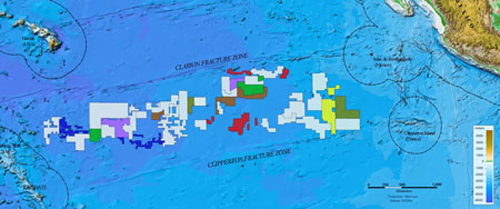- California Assembly OKs highest minimum wage in nation
- S. Korea unveils first graphic cigarette warnings
- US joins with South Korea, Japan in bid to deter North Korea
- LPGA golfer Chun In-gee finally back in action
- S. Korea won’t be top seed in final World Cup qualification round
- US men’s soccer misses 2nd straight Olympics
- US back on track in qualifying with 4-0 win over Guatemala
- High-intensity workout injuries spawn cottage industry
- CDC expands range of Zika mosquitoes into parts of Northeast
- Who knew? ‘The Walking Dead’ is helping families connect
New technology allows mineral extraction from manganese nodules

A new mineral extraction technology using manganese nodules developed by a Korean government agency will allow the nation to profit from tones of minerals buried under seabed in the Clarion-Cliperton zone, above, for next 100 years. (Courtesy of soest.hawaii.edu)
By Ko Dong-hwan
The Korean Government has successfully tested a technology to extract minerals from manganese nodules, opening a new way to capitalize on rich oceanic mineral reserves, the Ministry of Oceans and Fisheries announced on Thursday.
The ministry said it extracted copper, nickel and cobalt from a manganese nodule raised from the seabed at 5,000 meters deep.
The nodule was first dried and crumbled into smaller bits. Additives and reducing agents, including limestone, were then added. After melting the mixture at 1,450 degrees Celsius, the minerals were extracted from the liquid.
The ministry said the test showed the technology was feasible.
The Korea Institute of Geoscience and Mineral Resources developed the technology at a Dongbu Metal factory in Donghae city, Gangwon Province.
“This success has given us a core key to commercialize the minerals,” said a ministry official. “The extraction process generally takes up about 60 percent of the entire investment costs, so this new method will hopefully make the process cheaper.”
The method is expected to replace annual imports worth 2 trillion won.
Korea had acquired sole prospecting rights over the Clarion-Cliperton zone, about 2,000 kilometers southeast of Hawaii, from the International Seabed Authority in 2002.
The area is estimated to contain about 560 million tons of manganese nodules, which will allow Korea to extract 3 million tons of manganese nodules each year for 100 years – worth about $370 billion, or 395 trillion won.
The ministry plans to develop further technologies to extract other minerals from under the sea.














